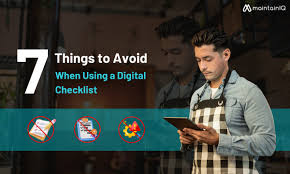A digital checklist can be one of the most powerful tools in your workflow. It brings structure, accountability, and visibility into everything you do. Whether you are managing client projects, planning a renovation, or running a small team, a good checklist keeps your process consistent and reliable.
However, many people make the mistake of treating digital checklists as simple to-do lists. They create them quickly, without thinking about how the structure will actually help them get work done. Over time, these poorly built checklists cause more stress than they remove. They get cluttered, confusing, and eventually ignored.
The truth is that creating an effective checklist takes a bit of strategy. You need clarity, focus, and discipline. A good checklist should feel like a roadmap, not a pile of reminders. In this post, we will look at the most common mistakes people make with digital checklists and explain how to fix them using clear examples and practical steps.
1. Mixing Unrelated Tasks in the Same Checklist
One of the most common reasons digital checklists fail is because they mix unrelated tasks. When work, personal, and admin tasks are all thrown into one list, it becomes messy and unmanageable. The purpose of a checklist is to provide focus, not to overwhelm you with different priorities fighting for attention.
According to the checklist experts, having a clear purpose is the key to making a checklist that works.
Every checklist should serve one clear purpose. This helps your brain focus on what needs to be done without switching contexts every few minutes.
Example:
You create a checklist titled “Tasks” and add:
- Write project report
- Buy groceries
- Schedule dentist appointment
- Send client proposal
You open the list in the morning and spend more time deciding where to start than actually doing the work. The context keeps changing, and focus disappears.
Fix:
Separate your checklists into categories.
- Work Projects: Deliverables, client communication, reporting.
- Personal Errands: Bills, shopping, appointments.
- Home and Life: Maintenance, cleaning, and family admin.
Each checklist should represent a single area of your life or business. When you open it, you know exactly what kind of work to expect.
2. Writing Tasks That Are Too Vague
A vague checklist item is a productivity killer. When you write something like “update website” or “work on presentation,” it feels productive at first, but it offers no direction. When you come back to it later, you have to think about what it really means, which slows you down and makes you more likely to delay starting.
The most effective checklists include specific, action-oriented tasks that you can complete in one sitting. Each task should tell you exactly what to do next.
Example:
“Work on proposal”
“Write pricing section for proposal and upload draft to shared folder.”
The second version removes all ambiguity. You know what needs doing and what finishing looks like.
Fix:
- Start every task with an action word: write, send, review, test, or submit.
- Break complex goals into smaller, clearer steps.
- Make each step specific enough to complete without hesitation.
This level of detail helps you stay in motion instead of getting stuck trying to interpret your own notes.
3. Making Your Checklists Too Long
Long checklists might feel thorough, but in practice they are exhausting. When you scroll through a never-ending list, motivation fades quickly. It feels like you are always behind, no matter how much progress you make.
Shorter, focused lists create a sense of momentum. The goal is not to record everything you could possibly do but to track what you can realistically achieve within the next timeframe.
Example:
You build a daily checklist with 40 items ranging from quick emails to major reports. By lunchtime, you have finished five tasks and still see dozens waiting. The visual overload creates guilt rather than satisfaction.
Fix:
- Limit daily checklists to 5–10 core tasks.
- Move non-urgent or future work to a separate “Later” or “Backlog” list.
- Use weekly or monthly lists for larger goals.
Finishing smaller checklists feels satisfying and builds motivation to keep going. A sense of completion is powerful.
4. Forgetting to Review and Update Checklists
A checklist should evolve as your workflow changes. Too often, people create a digital checklist once and then keep reusing it without review. Over time, it fills up with outdated steps, irrelevant notes, or duplicate items. The result is a list that no longer reflects how you actually work.
When your checklist stops matching reality, it loses trust. You start skipping steps or ignoring it entirely.
Example:
You have a “Weekly Content Checklist” that still includes “Publish on Facebook,” even though your company stopped using Facebook months ago. Each week, you scroll past that step, wasting time and mental space.
Fix:
- Schedule a short review session at least once a month.
- Remove outdated items and replace them with what you actually do.
- Add clarity to any steps that cause repeated confusion.
Treat your checklist as a living process, not a static document. When you refine it regularly, it stays accurate, efficient, and genuinely helpful.
5. Overcomplicating with Too Many Features
Digital tools are powerful, but that power can quickly turn into clutter. Many people overload their checklists with too many features — sub-tasks, dependencies, colour codes, reminders, tags, and custom fields. Instead of simplifying work, it makes the process harder to follow.
A checklist should be easy to glance at and understand instantly. When you spend more time managing the tool than completing the work, something has gone wrong.
Example:
You create a checklist in a project management platform with layers of subtasks, multiple colours, and nested folders. It looks impressive but takes effort to navigate. You waste time scrolling through menus instead of doing the work.
Fix:
- Start simple. Keep one layer of subtasks if absolutely needed.
- Use a few clear labels like “Today,” “This Week,” and “Done.”
- Add automation only after you have mastered the basics.
An effective checklist should feel light and frictionless. The best tools are the ones that help you think less about the process and more about the task itself.
6. Leaving Tasks Without Ownership
When checklists are shared across teams, one of the biggest problems is unclear responsibility. If tasks are unassigned, everyone assumes someone else is handling them, and nothing happens.
Every task should have a clear owner. Assigning ownership is not about micromanagement; it’s about accountability and clarity. When each person knows exactly what they are responsible for, projects move forward faster and communication improves.
Example:
A team creates a shared checklist for an upcoming event. Tasks like “Confirm catering” and “Send invitations” have no names next to them. The week of the event arrives and half the tasks remain undone because no one realised they were responsible.
Fix:
- Assign each task to a person.
- Add due dates or checkpoints.
- Use comments or notes to clarify expectations if needed.
This turns a shared list into a clear workflow where everyone knows their part.
7. Ignoring Progress Tracking
Many people use digital checklists purely for ticking boxes. While that feels satisfying, it misses a major advantage of digital tools: progress tracking. Seeing trends in your completion rate, missed deadlines, or recurring problem areas provides insight into how you actually work.
Without reviewing your data, you lose the chance to improve your process.
Example:
A maintenance team uses digital checklists for daily inspections. Over time, the same step — “Check generator oil level” — keeps getting skipped. Because no one tracks completion data, the issue goes unnoticed until the generator fails.
Fix:
- Review completed checklists weekly or monthly.
- Look for missed or repeated items.
- Use the reporting features built into your checklist software to identify patterns.
The aim is to learn from your process, not just record it. A checklist that teaches you something about your habits is one that keeps improving with you.
8. Choosing the Wrong Software for Your Digital Checklists
Selecting the right software is one of the most important steps in building a digital checklist system that actually works. The best tool depends on how you work, the size of your team, and how often your tasks repeat.
Some people choose the wrong platform because it looks visually appealing or because it is popular, only to find out it doesn’t fit their workflow. The right tool should feel natural and easy to use. It should match your habits, not force you to change them completely.
Example:
A small business owner starts using an enterprise-level project management tool because it promises automation and analytics. Within weeks, the team is overwhelmed by options they do not need. Instead of improving productivity, the system creates confusion.
Fix:
When choosing your software, ask these questions:
- How complex are your checklists?
- If you need something simple, use tools like Microsoft To Do or Todoist.
- For collaborative work, use Trello or ClickUp.
- For recurring processes and standard operating procedures, try Process Street or Manifestly.
- Do you need automation or reporting features?
- If yes, pick a tool that integrates with your existing systems.
- Will you access it mostly on desktop, mobile, or both?
- Mobile-friendly tools are best if you work on the go or manage field staff.
Test each tool with a small checklist first before migrating everything. The right platform should make your work feel lighter, not heavier.
For more guidance, check out this guide on picking the best checklist software from So List blog.
Conclusion
Digital checklists can completely transform how you work when they are built properly. But when they are vague, overloaded, outdated, or left unmanaged, they become a distraction rather than a tool.
To build a strong digital checklist, keep it focused, specific, and simple. Review it regularly, assign ownership where needed, and use progress tracking to spot trends. The goal is clarity — to know exactly what needs to be done, when it needs to be done, and who is responsible for doing it.
A good checklist should feel calm, efficient, and reliable. It should guide you through your day, not demand more effort to manage. When you design it with intention, it becomes more than a productivity tool. It becomes a structure that keeps your business, your projects, and your life organised.





